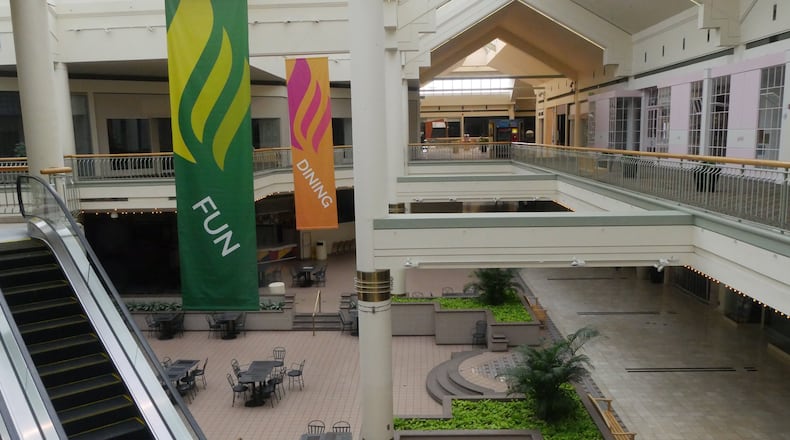Bill Gullion told me he helped throw a party for 3,000 people the night before the opening of Gwinnett Place mall, where he was the first general manager.
Doormen wore tuxedos and white gloves, according to a news story at the time. The governor and Miss Georgia attended the ribbon cutting the next day, but there wasn’t enough parking to handle the crowds, including 6,000 people who waited on a weekday morning for stores to open. Gullion recalled a two-mile-long line of vehicles on I-85 headed his way.
It was early February 1984, a moment that symbolized the enthusiasm and economic potential of Gwinnett and much of the rest of Atlanta’s suburbs.
It wasn’t misplaced. Eventually, I’m told, Gwinnett Place became a middle-income powerhouse, the number two mall in Georgia, only barely behind fancy Lenox Square in sales per square foot.
Ah, the past.
For an 82-year-old former mall guy like Gullion, there are lessons to be learned.
“It’s like nature: everything changes,” Gullion told me.
Immobile creations are vulnerable to shifts in what and who is around them and where the competition goes.
Two gone
Two of the Atlanta area malls Gullion worked at — Shannon (he was the first general manager there, too) and Avondale — are dead and gone now.
Another, Gwinnett Place, is teetering badly. It was struggling even before the recent news that stunned Gullion: the body of a deceased 19-year-old woman went unnoticed for weeks in a back room of a vacant eatery in the food court. Gullion emailed me after seeing a column I wrote about the tragedy in the midst of the mall's long, sad decline.
It had been years since he last visited Gwinnett Place, he wrote.
“I was so depressed by what I saw, I vowed never to return. And I haven’t. That’s how badly the property had digressed.”
Gangbusters
Gwinnett Place was built in what was still a largely rural area along Pleasant Hill Road, Gullion told me. Developers had thrown up houses at a blistering pace elsewhere in the county, but some doubted whether there would be enough business for the mall. They were wrong.
“My God, it was gangbusters when we opened it up,” said Gullion, who worked for Canadian-based developer Cadillac Fairview and, later, Scott Hudgens, probably the most prolific mall developer in Georgia.
They out positioned rivals. Gwinnett Place opened with four food courts and top anchors of the time (Davison’s, Rich’s and Sears). It pulled in shoppers from Gwinnett, north Fulton, DeKalb and portions of north Georgia and peeled business away from Perimeter and Northlake malls, Gullion recalled.
But not every real estate gamble turned out as planned. Around Gwinnett Place, the median income of area residents was solid but not quite as high as hoped for by Cadillac Fairview, he said.
Behind the struggles
I talked to a couple other people who were involved in Gwinnett Place back in the day.
The concern in recent years, commercial real estate veteran Tom Wheeler told me, is that too many malls were built and the number of strong, credit-solid tenants has declined sharply
Of course, the rise of online and mobile shopping keeps carving away more sales and the growth of many traditional store fronts.
And the mall's latest owner, Moonbeam Capital, hasn't risen to deal with the challenge, Wheeler said. "What the mall needs is better ownership: people with a vision that have the capital to execute the vision."
Mike Lowrey was a general manager of Gwinnett Place a few years after Gullion, serving from 1989 to the early 2000s. Much of that period marked the mall’s peak.
Then Hudgens, who was a part owner in Gwinnett Place, opted to help develop the Mall of Georgia farther north in the county, figuring if he didn’t do it, somebody else would. That cut off Gwinnett Place from north Georgia.
Then a competing developer erected what is now Sugarloaf Mills about three miles from Gwinnett Place. That was the most damaging blow, Lowrey said. It left Gwinnett with three malls.
“In the back of our mind, we knew one of them had to fade,” he told me.
“Sales took a hit and never really recovered,” said Lowrey, who later became the general manager at the Mall of Georgia. “Demographic changes [in the Gwinnett Place area’s population] may have exacerbated the situation, but that was not the primary cause” of the Duluth mall’s decline.
Notice the common theme? When Gwinnett Place was built, it succeeded in part because it squeezed business from existing older malls. And it later faltered when newer malls did the same to it.
Lowrey told me he had brainstormed other options for Gwinnett Place, including taking the roof off part of it, as well as bringing in big box retailers. But he said he kept running into challenges from the mall’s other property owners. Department stores owned their locations and, crucially, major changes to the mall had to be approved by every owner.
“We could never get unanimous consent on anything,” he told me.
Now what?
Malls like Gwinnett Place aren’t easy or cheap to try to fix.
“What the hell do you do with them at the end when they are not any good?” Gullion asked.
He told me he spent months on site during Gwinnett Place’s construction. One of his sons worked on the foundation. Another helped on the waterfall, which in the first few years cascaded from the second floor to the first floor.
Guillion put in a lot of time at the mall once it opened. The waterfall was a maintenance headache, but it was his favorite spot in the entire million-square-foot complex. Sometimes, if someone called in sick, it was him out in the parking lot picking up litter. He walked the length of the mall maybe three times a day, doing inspections. (Now, he told me, “I don’t walk too good.”)
He told me he was appalled to read in my recent column that not a single business is operating in what became the mall’s centralized food court.
“How does a community put up with something that was an asset but now is a deficit?” he asked.
Then the guy who helped bring Gwinnett Place into the world told me this: “I think it maybe has reached the stage of where you ought to think about tearing it down.”
Some other columns you should check out:
Want more Kempner? Find his columns here: http://www.myajc.com/news/opinion/matt-kempner-unofficial-business/j9F7R2mOGomS5FMjfhho2O/
Check Matt on Facebook (https://www.facebook.com/mattkempnercolumnist) and Twitter (@MattKempner) or email him at mkempner@ajc.com.
About the Author
Keep Reading
The Latest
Featured



